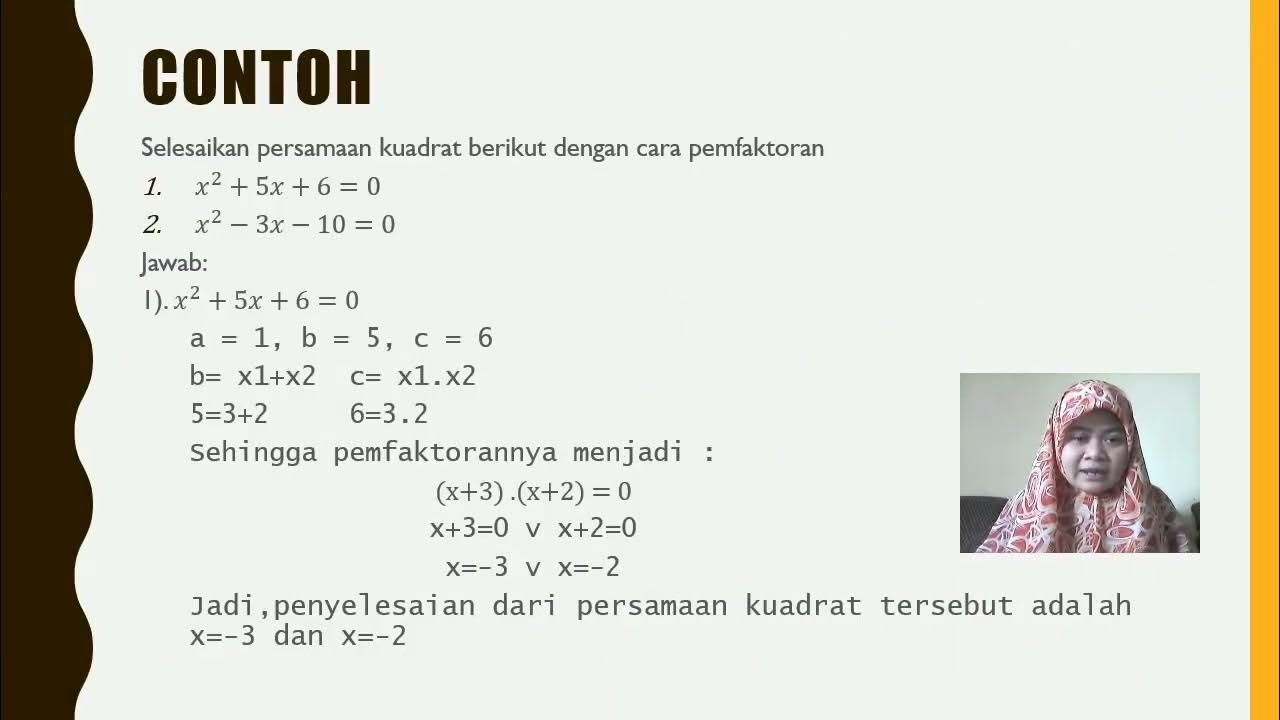ILLUSTRATING QUADRATIC EQUATIONS || GRADE 9 MATHEMATICS Q1
Summary
TLDRThis educational video script introduces the concept of quadratic equations, focusing on how to identify and arrange them into standard form, ax^2 + bx + c = 0. It explains the significance of coefficients a, b, and c, and provides examples to illustrate the process. The script emphasizes the importance of a being non-zero and the equation retaining its quadratic nature even if b or c equals zero. It concludes with an encouragement to like, subscribe, and stay tuned for more informative content.
Takeaways
- 📚 The video is about teaching how to identify the coefficients a, b, and c in a quadratic equation.
- 🔍 It emphasizes that a quadratic equation is in the standard form ax^2 + bx + c = 0, where a, b, and c are real numbers and a ≠ 0.
- 📐 The terms of the quadratic equation are defined: ax^2 is the quadratic term, bx is the linear term, and c is the constant term.
- 📉 The video provides examples of how to rearrange equations into the standard form and identify a, b, and c values.
- 🔢 It explains that if 'a' is 0, the equation becomes linear, not quadratic.
- 🚫 The importance of 'a' being a positive real number is highlighted to maintain the equation as quadratic.
- 📝 Examples given include equations like x^2 - 5x + 3 = 0, where a=1, b=-5, and c=3.
- 🔄 The process of converting equations into standard form by moving terms and changing signs to fit ax^2 + bx + c = 0 is demonstrated.
- 📌 The video clarifies that even if b or c equals 0, the equation can still be quadratic as long as a ≠ 0.
- 📘 It also covers how to handle equations with no linear term (b value) or no constant term (c value).
- 👍 The video concludes by encouraging viewers to like, subscribe, and hit the bell for more content.
Q & A
What is a quadratic equation?
-A quadratic equation is a polynomial equation of the second degree, typically written in the form ax^2 + bx + c = 0, where a, b, and c are constants, and a ≠ 0.
What are the three terms in a quadratic equation?
-The three terms in a quadratic equation are the quadratic term (ax^2), the linear term (bx), and the constant term (c).
What is the standard form of a quadratic equation?
-The standard form of a quadratic equation is ax^2 + bx + c = 0, where a, b, and c are real numbers and a is not equal to zero.
How do you identify the values of a, b, and c in a given quadratic equation?
-To identify the values of a, b, and c, first write the equation in standard form. The coefficient of x^2 is a, the coefficient of x is b, and the constant term is c.
What happens if the coefficient 'a' in a quadratic equation is zero?
-If the coefficient 'a' is zero, the equation is no longer quadratic but becomes a linear equation.
What is the significance of the coefficient 'a' being positive in the standard form of a quadratic equation?
-The coefficient 'a' being positive in the standard form ensures that the quadratic term is correctly represented and that the equation is in its proper form.
How do you rewrite the equation x^2 - 5x + 3 = 0 in standard form?
-The equation x^2 - 5x + 3 = 0 is already in standard form, with a = 1, b = -5, and c = 3.
What is the quadratic term in the equation 7x^2 - 1/3x = 0?
-The quadratic term in the equation 7x^2 - 1/3x = 0 is 7x^2.
What is the linear term in the equation 6x^2 = 9?
-In the equation 6x^2 = 9, there is no linear term (no x term), so the linear term is considered to be 0.
How do you determine the constant term in the equation -8x^2 + x = 6?
-To determine the constant term in the equation -8x^2 + x = 6, you need to rearrange it to the standard form -8x^2 + x - 6 = 0, where the constant term is -6.
What is the process of converting a quadratic equation into standard form?
-To convert a quadratic equation into standard form, you need to rearrange the terms so that the equation is in the form ax^2 + bx + c = 0, ensuring that a is the coefficient of x^2, b is the coefficient of x, and c is the constant term.
Outlines

This section is available to paid users only. Please upgrade to access this part.
Upgrade NowMindmap

This section is available to paid users only. Please upgrade to access this part.
Upgrade NowKeywords

This section is available to paid users only. Please upgrade to access this part.
Upgrade NowHighlights

This section is available to paid users only. Please upgrade to access this part.
Upgrade NowTranscripts

This section is available to paid users only. Please upgrade to access this part.
Upgrade NowBrowse More Related Video

INTRODUCTION TO QUADRATIC EQUATIONS | GRADE 9

Persamaan Kuadrat •Part 1: Menyelesaikan Persamaan Kuadrat dengan Pemfaktoran / Faktorisasi Tipe 1&2

Intro to Quadratic Functions (Relations) - Nerdstudy

Persamaan Kuadrat part 1

Persamaan Kuadrat Kelas 10 Kurikulum Merdeka

Pemfaktoran Suku Bentuk Aljabar - bagian 2 💡Pasti Bisa
5.0 / 5 (0 votes)